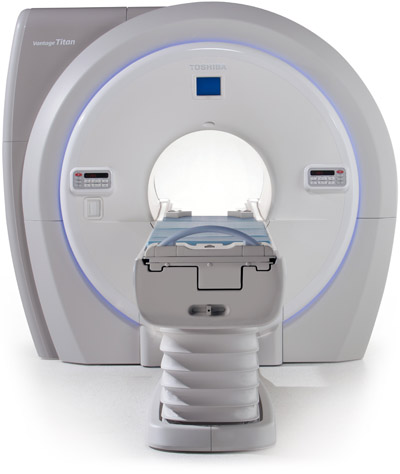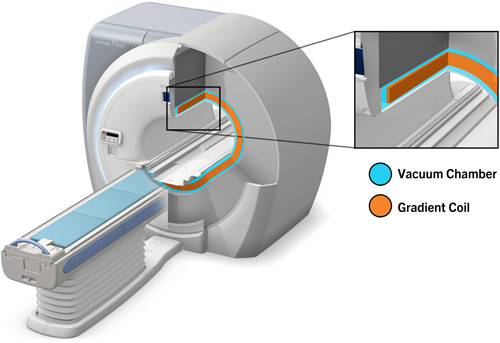
MRI Noise Reduction Patients Can Hear
Toshiba’s Pianissimo Making MR Quiet for Almost 15 Years
It’s one of the biggest complaints patients have with MR imaging. The loud acoustic noise produced by the powerful gradient coils can cause extreme discomfort for patients. Combine that with traditionally small bore sizes, and there are many patients who can’t get the diagnostic exam they need.
Enter Toshiba America Medical Systems, Inc., which pioneered quiet and patient-friendly MR technology almost 15 years ago and continues to innovate today. Transforming the patient experience, Toshiba’s MRI systems feature the PianissimoTM noise-reduction technology, while its Vantage TitanTM line has a large 71 cm bore opening.
Patient Issues with Loud MRI
The loud noises typically associated with MRI examinations originate from the gradients that vibrate during image acquisition. When charged particles, such as electrons, travel through a magnetic field, they will experience a force that deflects their trajectory. If the direction of the current is changed rapidly enough, the coils will begin to vibrate, and this vibration is transmitted to the gantry in the form of acoustic noise.
With today’s faster scan sequences, more powerful gradients and stronger static magnetic fields, the acoustic noise grows exponentially.
With noise levels approaching those of a rock concert or jackhammer, there are many patients who aren’t able to have an MRI. And patients who can tolerate the noise are often uncomfortable and have difficultly staying still. This results in unnecessary rescans and longer procedure times.
Add to that healthcare reform tying reimbursement to patient satisfaction, it is now more important than ever to provide patients with a better experience.
How Pianissimo Works
Originally introduced in 1999, Toshiba’s Pianissimo technology is a breakthrough hardware solution that reduces MR noise at the source by up to 90 percent or 33 dB(A) on both 1.5T and 3T systems.
It accomplishes this in three main ways:
- Vacuum Chamber: The gradient coil is vacuum-sealed, which prevents acoustic noise propagation.
- Sound-Dampening Materials: Special insulation is installed between the vacuum vessel and the magnet to further dampen sound and minimize the vibrations transmitted to the magnet.
- Silent Pulse Sequences: In addition to Pianissimo, Toshiba’s systems also provide special sequences designed to further reduce gradient noise.
Building the vacuum chamber and sound-dampening materials into the system reduces noise on all exams. While other noise-reduction technologies only work for very limited types of sequences, Pianissimo allows even the most sensitive patients to have a pleasant experience during the whole exam.
The technology also comes standard on Toshiba’s entire Vantage™ MR product line, so hospitals don’t have to pay extra to make their patients feel more comfortable.
Patients and Clinicians Recognize the Difference
Hospitals and imaging centers can provide a better experience for their patients and increase referrals because of Pianissimo.
Take, for instance, Winn Army Community Hospital, which installed Toshiba’s Vantage Titan 3T. Clinicians at the hospital were surprised by the dramatic noise reduction, and one patient didn’t even realize his exam had taken place.
“Recently, we conducted an MR exam with one of our lieutenants, who asked if the system was on because it was so quiet. The noise-reduction technology truly addresses one of the major compliance issues in MR,” said Brad Wilkes, MRI technologist, Winn Army Community Hospital.
Making the Case for Pianissimo
By improving the MRI experience, Pianissimo delivers compelling patient, clinical and business benefits. Exams are completed smoothly and patients go home happier.
Patients should never have to avoid a diagnostic exam because of noise. Pianissimo solves this problem with a truly quiet MR exam where patients and clinicians can hear the difference.




